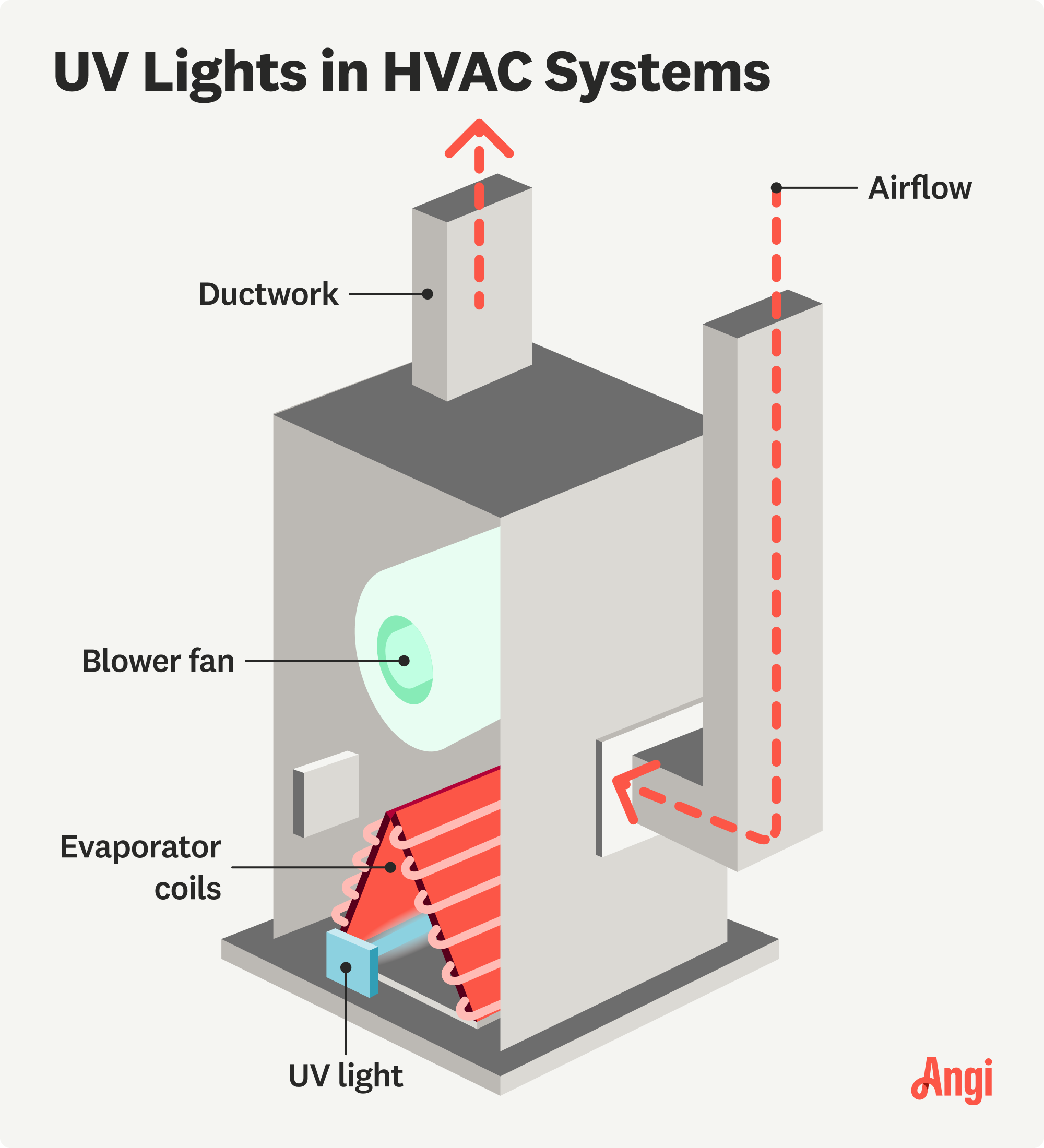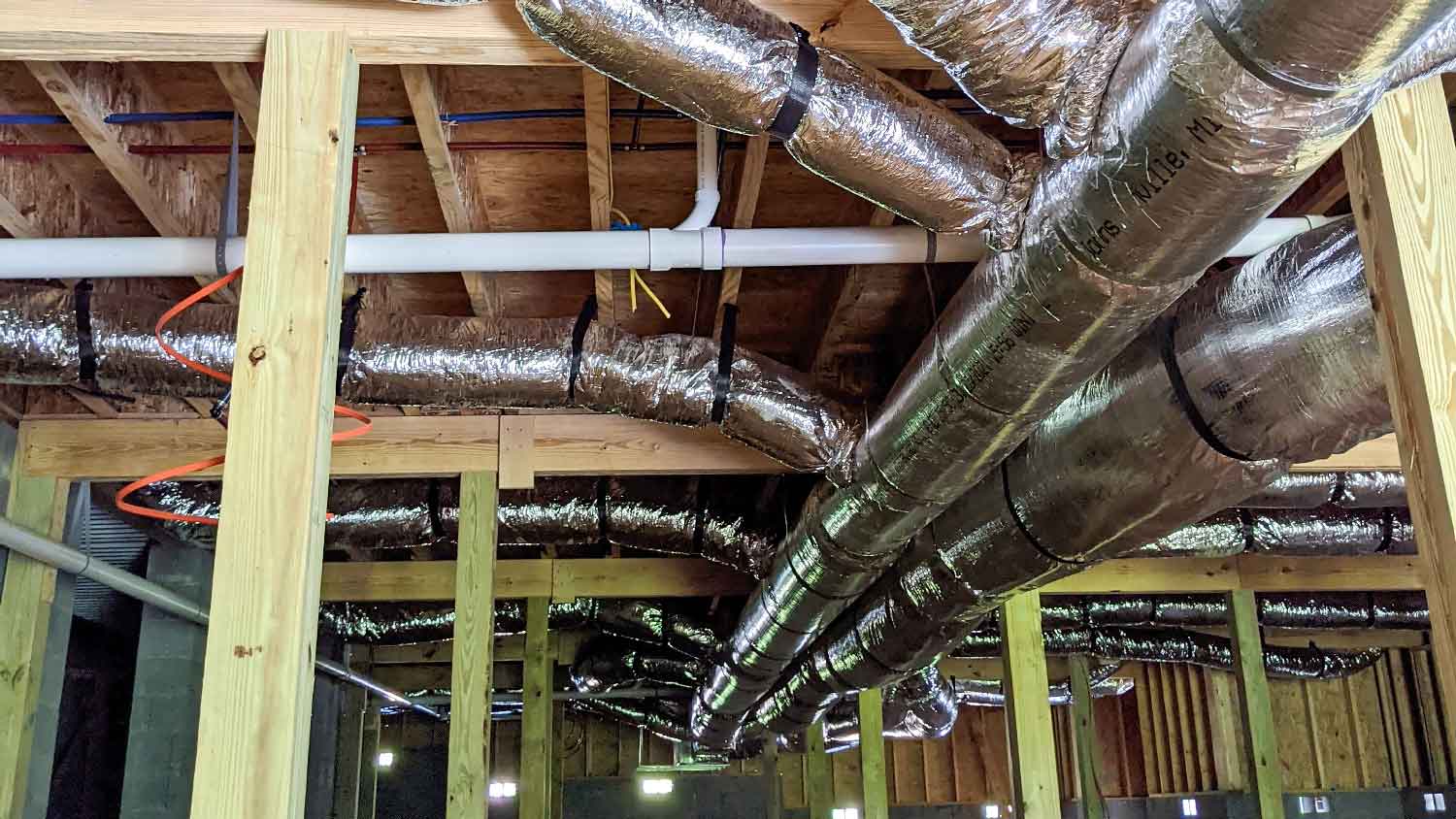
Gas furnace replacement costs depend on the type of furnace you want and installation fees. Our guide explains all the factors involved in a new furnace cost.
HVAC UV lights can help everybody breathe a little easier


HVAC ultraviolet (UV) lights remove potentially harmful compounds, like mold and bacteria, from the air in your home.
In addition to making breathing easier, UV lights help HVAC units function more efficiently and become damaged less easily.
HVAC UV lights don’t remove dust and dander from air circulation, so you might opt for another solution if this is your problem.
Installing an HVAC UV light benefits everyone in your home, especially those with allergies and respiratory issues. HVAC UV lights purify the air traveling through your HVAC system and remove contaminants like bacteria and germs. This guide will explain the benefits of installing an HVAC UV air purifier in your home, what you can expect after installation, and the basic costs of the job.
Ultraviolet lights are an HVAC system upgrade that helps fight allergies and improve air quality. You can install them inside your furnace, air conditioner, heat pump, or ductwork to kill bacteria, mold, mildew, allergens, and other germs—before they enter your home (and lungs).
Eliminating these compounds from your home’s systems also keeps them running more efficiently. Without the buildup of microorganisms, such as mold and even algae, air moves more freely and keeps your home heated or cooled to the temperature you desire.
Pretty much everyone benefits from breathing better air, especially considering that Americans spend as much as 90% of their time indoors (where pollutants are two to five times higher on average, according to the Environmental Protection Agency).

UV lights in your HVAC system can help improve the overall air quality of your home by killing bacteria, viruses, and other contaminants before they have the chance to spread to household members. This feature can effectively eliminate pesky impurities in indoor air to lessen odors and potential health issues.
When taking on this project, expect questions only a pro can answer. With our network of local pros, you'll get the job done and your questions answered—without the hassle and stress of doing it yourself.

If you’re considering adding UV lights to your HVAC system, there are only two types to choose from. Keep reading to find out how they vary, including the differences in cost.
Coil sterilization is the most common type of UV light for HVAC systems because it’s less expensive than air sterilization and similarly effective. A stick-type light mounts inside the return air duct, where it kills harmful compounds accumulating on the air handler coil. Coil sanitizing lights cost between $60 and $280, not including installation and bulb replacements.
Unlike coil sterilizing lights—which are pointed at the air handler coil to sterilize anything on it—this UV light system kills harmful compounds on moving air. A complete UV light unit is hardwired directly into the air ducts to sanitize air as it enters the machine. Because this system is more comprehensive than coil sterilization, materials and installation cost more. Except to pay between $80 and $400 for the light unit itself.
Although HVAC UV lights may seem like they offer nothing but benefits, there are also a few downsides to consider before making the investment. Here are the pros and cons of having UV lights in an HVAC system.
| Pros | Cons |
|---|---|
| Improved airflow | Doesn’t work on dander and dust |
| Reduced electricity costs | Costly to install and replace bulbs |
| Less clogging in drain lines | Regular maintenance required |
| Minimizes allergies | You still need to buy AC filters |
HVAC UV lights come with many pros, from reducing allergies and energy costs to preventing common AC damages. Find out how an addition like this can improve your life below.
HVAC UV lighting improves indoor air quality and airflow by removing particles like mildew and bacteria. This allows your machine to run more efficiently and produce better, cleaner air.
UV lights prevent problem-causing compounds from forming in your HVAC unit. This allows the machine to operate more efficiently and use less energy overall, which may decrease your energy costs.
With less mold and mildew circulating through your HVAC system thanks to a UV light unit, you’re also less likely to experience clogged drain lines—one of the more common AC problems.
UV lights sterilize and minimize the effects of mold, mildew, and bacteria. Adding one to your HVAC system can even prevent things like the common cold from circulating in your household.
While it’s true that UV light units for HVAC systems have a lot going for them, there are a few reasons why an addition like this might not be right for you.
UV lights zap away things like bacteria and mold, but they do not eliminate dander or dust. If factors like these cause your allergies, there are other HVAC system updates you can do to feel better, like installing an air purifier.
Even if you go the DIY route, the costs to install and maintain UV lights in an HVAC unit range from $170 to $800 for everything involved. Plus, you’ll need to replace the bulbs once a year to ensure their effectiveness; they cost $10 and $125 on average. The extra expense may be worth it if you’re suffering from issues that UV lights can solve—like mold from excessive moisture and humidity—otherwise, you’re better off looking for another, more affordable solution.
UV light bulbs function less effectively when covered in dust, so you’ll need to clean them fairly often to ensure this is never the case—roughly once every couple of months and possibly more if you live in an especially dusty place.
Even with UV lights in your HVAC unit, air filters are still necessary to remove particles like dust and dander from the air before it circulates through your home.
You should seriously consider installing an in-duct UV air purifier when you or your family suffer from allergies or respiratory issues. If that isn’t happening, this project probably doesn’t need to be a top-priority HVAC upgrade for your home.
However, installing a UV HVAC air purifier could be a proactive step for those living in wet and humid climates. High-moisture areas are more susceptible to mold growth, meaning installation now could be a good long-term investment.
The cost to install UV lights in an HVAC system depends on the type of lights you choose and whether or not an HVAC pro sets them up. Coil sterilization lights are easier to install and cost less—between $100 and $225 on average. By contrast, air sterilization lights require more work to set up and are more costly to install—usually between $150 and $295 for labor alone.
While it is possible to DIY installation for both coil and air sterilization lights, this project requires equipment and know-how to ensure your HVAC system isn’t damaged accidentally. Consider leaving this job to an HVAC company near you. Even though you’ll pay more upfront to hire a professional, you’ll be less likely to spend more on repairs to your system down the line.
You can expect to feel relief—in both your wallet and your sinuses.
After installation, your home’s air quality can improve in just a few days. Because the UV lights only kill germs when your device is turned on, run your system for a few hours after installation.
In the long term, you could enjoy lower electric bills due to more efficient heating and cooling. And among the less-recognized HVAC UV light benefits, they also help keep your coils and drain pan clean, reducing both wear and tear and maintenance requirements.
HVAC UV lights are worth it if you or your family suffers from allergies or illnesses caused by germs or particles that no other tool can remedy. To determine whether or not they’re right for you, evaluate how you’re feeling. For instance, symptoms from black mold in an AC include headaches that go away when you’re outside, coughing, sneezing, rashes, nausea, and fatigue, and UV lights can prevent issues like this from forming in the first place.
If you’re just feeling sneezy but have no other symptoms, dust or dander could be the actual cause of your problem, and unfortunately, UV lights can’t fix those issues.
From average costs to expert advice, get all the answers you need to get your job done.

Gas furnace replacement costs depend on the type of furnace you want and installation fees. Our guide explains all the factors involved in a new furnace cost.

Discover the cost to install ductwork. Learn about average prices, cost factors, and tips to save money on your ductwork installation project.

When your HVAC system is acting up, it could be the blower motor to blame. See how much blower motor replacement costs and what impacts the price here.

If your furnace is making loud noises, it could be the first sign something is failing. This guide will go over some of your furnace’s most noisy issues.

Is your heat pump not blowing hot air? Several factors could be causing this issue, and we dive into seven of the most common heat pump issues.

A whole-house humidifier costs between $400 and $800, but can have an ROI of 40%. Learn if adding this HVAC appliance is worth it for you.